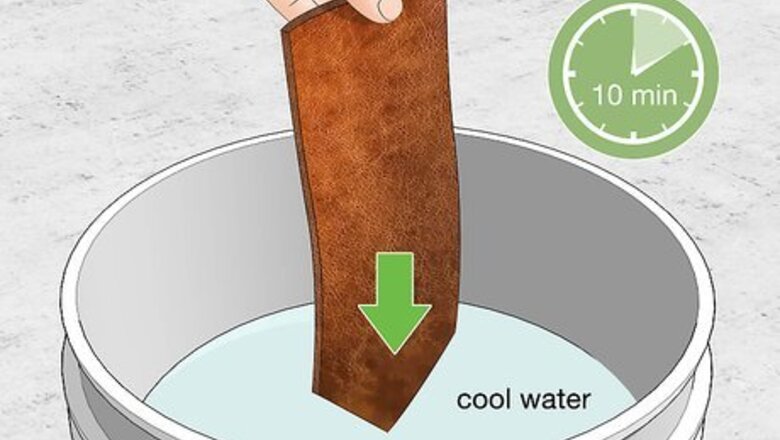
views
Water Soaking
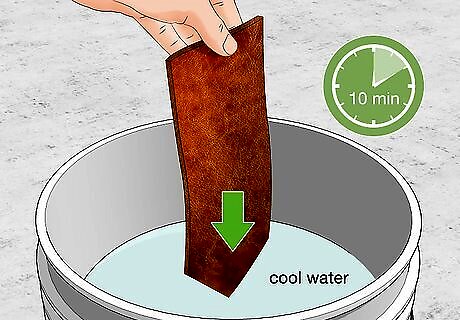
Soak the leather in cool water. Fill a large bucket or sink with cool to room temperature water. Immerse the leather in the water for about 10 minutes, or until it becomes thoroughly soaked. Note that this process works best when used with vegetable tanned leather. You can technically stiffen the leather by soaking it in nothing but room temperature water, but it will only become mildly harder and you will not be able to shape it. The addition of a hot water step will allow you to make structural changes while hardening the leather further.
Heat a second pot of water. As your leather soaks, fill a large stockpot with water and set it on the stove over high heat. Continue heating the water until it reaches a temperature of 180 degrees Fahrenheit (82 degrees Celsius). Use an accurate thermometer to keep track of the temperature. If the water is too hot or too cold, your results can vary dramatically from those described here. If you do not have a thermometer, you can gauge the temperature of the water by slowly heating it on the stove and testing it every minute or so with your bare hand. If you can keep your hand immersed in the water, it is safe to use that temperature for your leather. Once you can no longer bear to keep your hand in the water for more than an instant, remove the water from the heat source and do not allow it to get any hotter. Some people prefer to soak the leather in boiling water. Doing so stiffens the leather at a faster pace, but it also gives you less control. The resulting leather can become very brittle and may be unevenly stiff across its surface.

Dunk the leather in the hot water. Pull the leather out of the cool water and immerse it in the hot water. Let it remain there for a few minutes. After the first minute, you should already see the leather darken and curl. The longer you soak the leather, the stiffer it will become. If you soak the leather too long, however, it will be more brittle when dry. When using this method, soaking the leather in hot water for 30 seconds after it already darkens will result in a piece of leather that is hard but not inflexible. This means that the total hot water soak time would be about 90 seconds. Leave the leather in the water for a longer period of time if you want to make it stiffer.
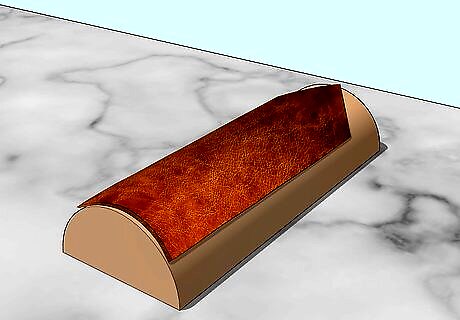
Shape as desired. When you pull the leather out of the water, it should be fairly flexible. If you need the form the leather into a specific shape, now is the time to do so. When wet, the leather will be stretchy and easy to form. This stretchiness will vanish within the first minute or two, though, so you need to work fast if you plan to stretch it out. The leather will still remain flexible for up to an hour after the stretchiness fades away, though.
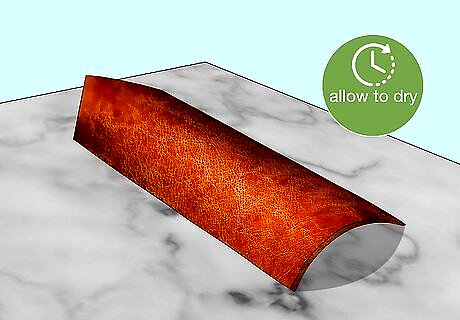
Allow the leather to dry at room temperature. Let the leather sit out at room temperature for several hours. After it dries, the leather should be notably thicker and stiffer. Stiffened leather will also shrink, so the piece you started out with may not look as large when you finish the process.
Baking

Soak the leather in room temperature water. Fill a sink, bucket, or similar container with cool to room temperature water. Immerse the leather in the water and let it soak until it becomes completely water logged. This process is generally recommended for use with vegetable tanned leather. The amount of time you leave the leather in the water will vary based on the thickness and quality of the leather. Usually, leaving it in the water for 10 to 30 minutes will suffice. The leather should be notably flexible when you remove it.
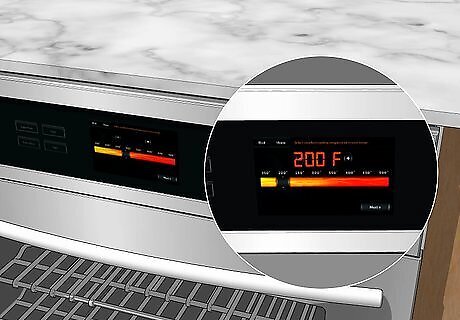
Preheat an oven. As the leather soaks, preheat the oven to 120 degrees Fahrenheit (50 degrees Celsius). Move the racks of the oven around as needed to clear enough room for the leather piece. If your oven does not reach a temperature this low, simply use the lowest temperature available. Note that higher temperatures could cause a little steam scalding, however, which may alter the color and cause more greater shrinkage.
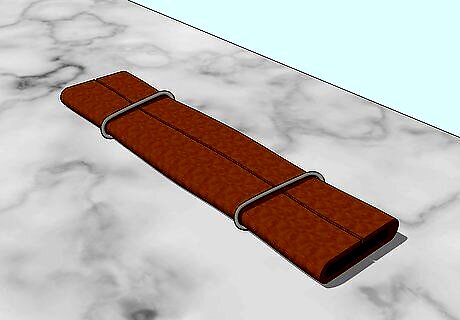
Mold the leather as desired. Take the leather out of the water. If you plan on forming it in any way, do so now, while it is still flexible and easy to handle. Since the leather is still fairly cool at this point, it may not keep its form when left alone. After shaping it, you should hold the new forms in place using string, stitching, or nails.

Bake the leather. Place the wet, shaped leather in the oven and bake it until it feels dry. Depending on how long you soaked the leather and the temperature of your oven, this can take anywhere from 20 to 90 minutes. You can let the leather remain in the oven even after it dries out, but know that dry baking it will cause the temperature of the leather to rise and the structure of the leather to become both harder and more brittle.
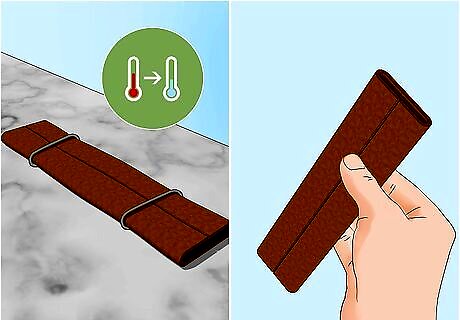
Let cool. Remove the hot, dry leather from the oven and let it cool at room temperature until it is safe to handle with your bare hands. During this time, the leather will continue to stiffen. Once cool, you should remove any string, thread, or nails holding the shape in place. If the leather has become sufficiently stiff, it should be able to hold its new form on its own now.
Waxing

Preheat an oven. Set the oven to 200 degrees Fahrenheit (90 degrees Celsius) and let it completely warm up. Make sure that the racks inside the oven are rearranged as needed so that the leather piece can fit inside without brushing against the racks or the sides of the oven. This method should work well with most types of leather, but vegetable tanned leather is still the easiest to work with. Also note that it tends to be a good method to use if you are trying to stiffen leather than has already been formed and does not need any additional shaping.
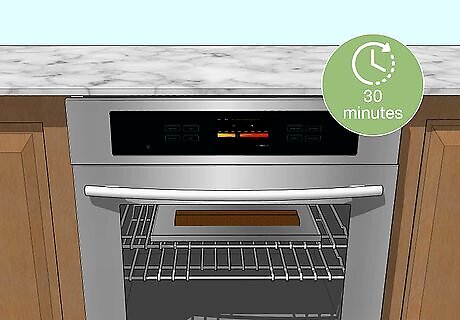
Dry bake the leather. When the oven is hot enough, place the leather inside and bake it for about 30 minutes. The leather needs to be notably hot to the touch when you take it out of the oven. The heat itself plays an important part in the stiffening process. Essentially, it liquifies some of the molecules in the leather, causing them to break down and become more flexible. When those molecules solidify again, they do so in a structure that is even harder than the leather's original chemical structure. If you allow the leather to get too hot, however, it can become too brittle by the end of the process.
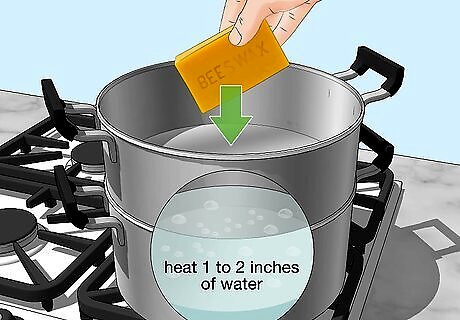
Melt a little wax. Place a block of beeswax into a double boiler and heat it until it completely liquifies. Do this step as the leather bakes so that the leather and the wax will be hot enough to proceed at the same time. Beeswax is the wax of choice, but you can use melted candles or nearly any other type of wax, as well. To melt the wax: Heat 1 to 2 inches (2.5 to 5 cm) of water in the bottom part of a double boiler placed on the stove over medium-high heat. Place the wax inside the top part of the double boiler. As the wax begins to melt, stir it with a disposable spoon or chopstick. Continue until the melts completely.
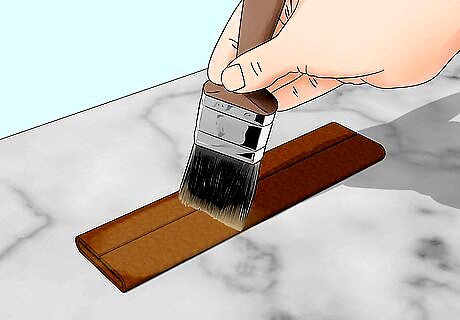
Paint the wax onto the leather. Take the leather out of the oven and place it on a few sheets of newspaper. Load a large paintbrush with melted wax and brush the wax onto the hot leather using even strokes. The leather should soak up the hot wax. If it does not do so, the leather is not yet hot enough and should be returned to the oven. Continue brushing the wax onto the leather until the leather cools and no longer absorbs the wax.
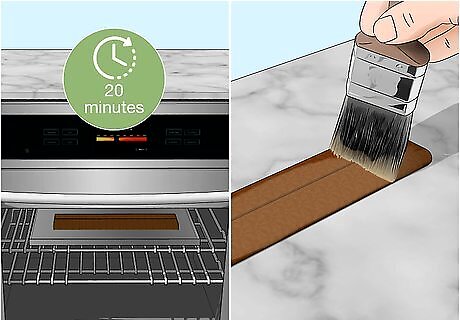
Reheat and repaint the leather as needed. After your initial coat of wax, place the leather back into the oven and heat it for another 20 minutes or so. Remove it from the oven and brush the surface with an additional coating of melted wax. You should repeat this process until the leather no longer absorbs any more wax, even when hot. One way to tell that the leather can no longer absorb wax is to look at the coloring. The wax will alter the color of the leather slightly. If the entire surface of the leather is an even color, it has likely absorbed as much wax as possible throughout the entire piece.
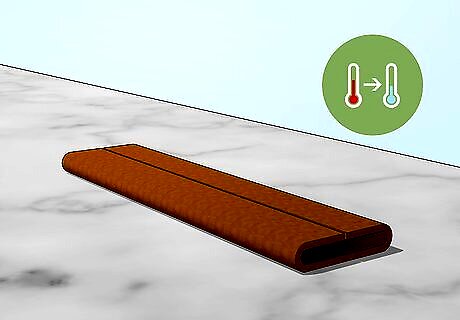
Cool completely. Let the leather cool and dry completely. When done, it should be extremely hard and nearly impossible to bend.


















Comments
0 comment